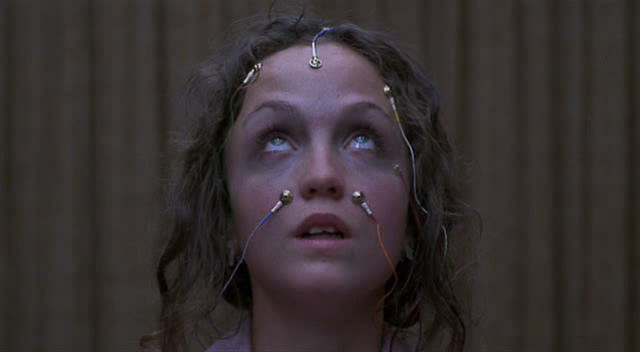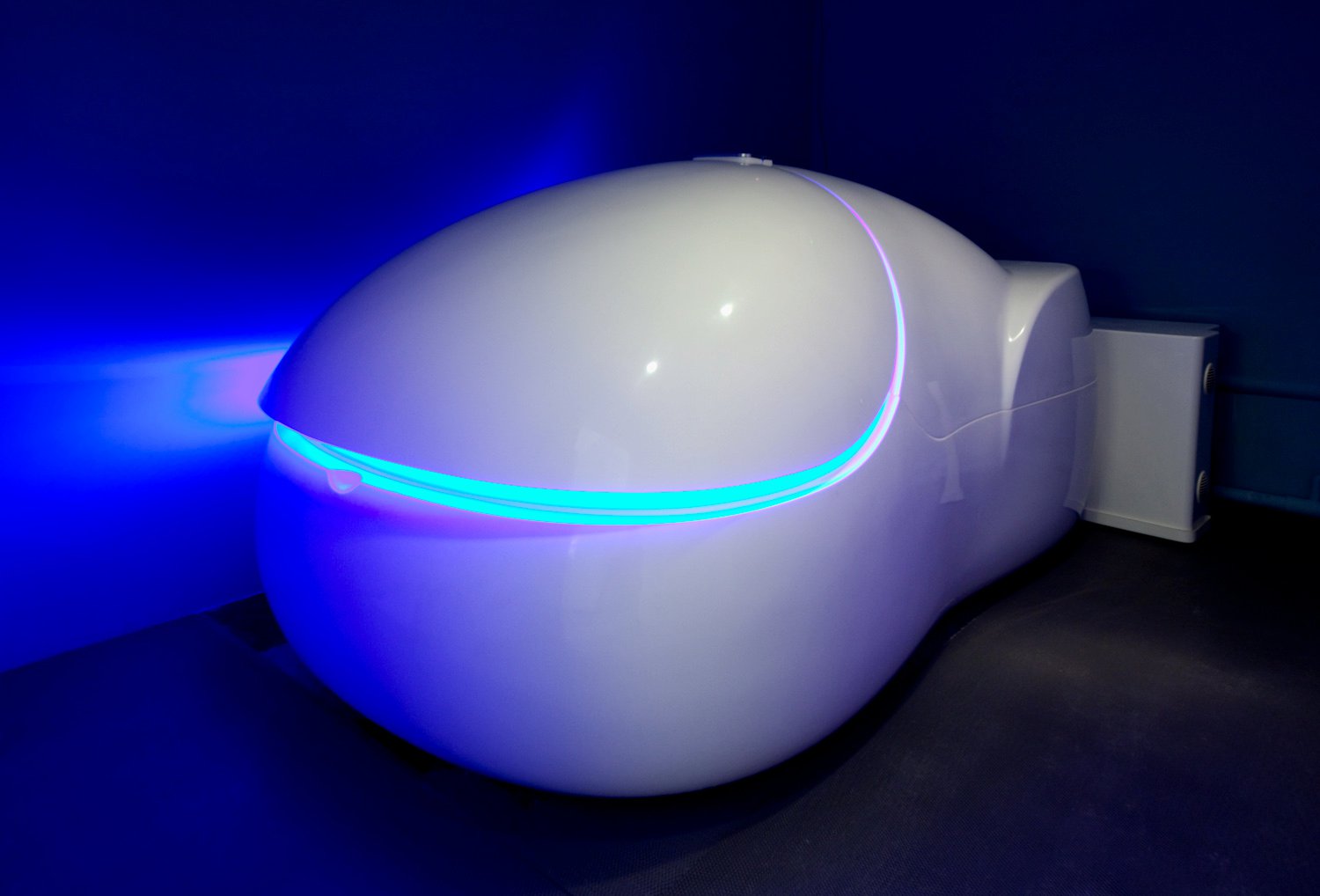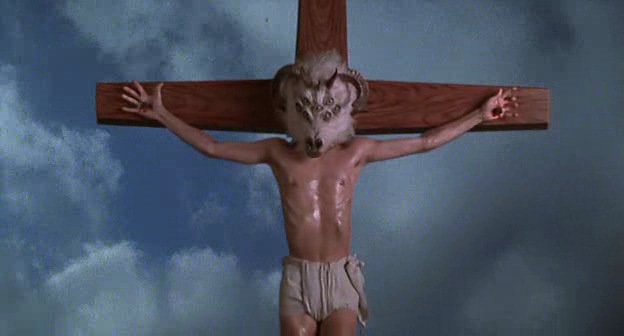“I feel like my heart has been touched by Christ,” says an unnamed schizophrenic in Ken Russell’s 1980 film Altered States. It is a line of dialogue that continues to resonate with the viewer long after they have finished watching the ridiculous but enjoyable romp. It reveals that while the British director had undoubtedly pitched a horror flick to Warner Bros, what he had actually delivered was the first head movie of the 1980s. It features William Hurt as Edward Jessup, a Harvard professor of abnormal psychology, whose research into schizophrenia sees him go off-piste with dramatic consequences. After becoming interested in the effects of sensory deprivation using an ‘isolation chamber’, he attends an Ayahuascan ceremony amongst indigenous Mexican tribesmen before heading back to America with an unnamed narcotic tincture with DMT-like properties. He starts turning on while floating and experiences strong hallucinations that start physically regressing him into a pre-human state. As you can imagine, there is plenty of scope for Russell’s primary colour, religion and sex-inspired hallucinatory celluloid madness. This film remains, to the best of my knowledge, the only film to feature Jesus with a seven-eyed goat’s head crucified in front of a waterfall of blood.
The premise of Altered States was loosely based on reality, however, and was made with the blessing of the real life Jessup, John C Lilly. This well-regarded writer, philosopher, neuroscientist, physician and psychoanalyst actually designed and built the first flotation tank in 1954 in order to carry out experiments into sensory deprivation. After becoming part of the psychedelic revolution and an enthusiastic friend of Dr Timothy Leary during the next decade, he started combining flotation sessions with experiments with LSD and ketamine. The 1960s was an intensely experimental phase of his career; this was when he also started trying to communicate with dolphins, wrote Programming and Metaprogramming in the Human Biocomputer: Theory and Experiments and started searching for life beyond the solar system.
However, his original primary goal was not intronautical travel, astronomical research or cetacean first contact; he was simply testing the assertion that without any kind of stimulation the brain would simply shut down or go to sleep. The lightproof tanks he designed were filled with water containing a large amount of dissolved Epsom salts, giving the subject a great buoyancy, and when the waters were heated to body temperature, very quickly the perception of a skin/water boundary evaporated – giving rise to the sensation of being suspended weightless in a void. The postulated theory on brain function did not hold water but it became (scientifically) clear that sessions in the tank had a demonstrably positive effect on stress and pain levels. So it is easy to see how the flotation tank has come to have associations with physical healing, psychedelic counterculture, new age spirituality and psychological stress relief, given that its creator was interested in all of these subjects at one stage or another.

“I feel like my heart has been touched by Christ” sums up exactly how I felt when I was given an adult strength pre- and post-med when I had eye surgery at the age of 14. This act of narcotic munificence by a kindly nurse sparked off a lengthy enthusiasm for psychedelic drugs and altered states of consciousness. I progressed rapidly from solvents to mushrooms to LSD and later through cannabis, ecstasy and MDMA via a short but enjoyable opium detour. Like the film Altered States though this was stupidity gloriously incarnate or, at best, psychedelia as pure hedonism. I started to realise that it wasn’t just drugs that could produce these heady effects but loud, heavy music as well. Bands such as My Bloody Valentine, Loop and the Butthole Surfers, while excellent with cough medicine or low-grade acid, provoked a certain effect on me even when sober. I started to understand why Godflesh featured a still from the film on the cover of their Streetcleaner album and the drug-wracked Ministry even sampled it on the bombastic apex of their career, Psalm 69.
While I still miss the act of sticking a giant gold spoon into my brain and giving it a good stir while listening to loud repetitive rock music and watching Threads with the sound on mute, I’m also glad for the sake of my nerves that my views on what constitutes a psychedelic experience have shifted slightly. If I considered this notion at all when I was a teenager or in my early 20s (and to be honest, I can’t remember that I did to any great extent), I probably thought of a good psychedelic experience as getting up enough psychic escape velocity to thrust me violently into some demented dreamscape of hitherto unimaginable weirdness. Nowadays, I still don’t devote that much time to ‘magickal’ contemplation but I do know that I think of psychedelia more in the terms of any experience that creates a different or unusual space for me to think in. In basic terms it stopped being a passive search for entertainment and obliteration and changed to a proactive quest for creativity and enlightenment – even if creativity usually meant just coming up with a good feature idea and enlightenment usually meant having an interesting new theory about the nature of the music produced by The Fall.
One simply reaches the age where even typing the words “crucified multi-eyed goat Christ in front of wall of blood” makes one feel faint. Non-chemical enlightenment is the way forward.

On arriving at Floatworks in South London – the biggest enterprise of its kind in the world – it certainly looks like the sort of place you would go to relax rather than have some kind of catastrophic vision. An enthusiastic man called James gives me the run down on the centre. They have six of the new style i-sopods at the centre, a client list of 1,500 customers and they also sell, install and maintain the units for home use. He is evangelical and praises the benefits of sessions which help sort everything from jet lag to back problems. Interestingly, it turns out he is an electronic musician himself and likes to listen to his own tunes while floating before deciding on what changes need to be made to them.
After taking a shower I get in the tank, which is ergonomic, white and plastic, with a hydraulic lid. It looks absolutely nothing like a steampunk coffin aboard the Event Horizon as you might expect and more like a futuristic battery-powered car from the film Sleeper. Ten minutes of silence has been programmed at the start of the album and it does take me this entire period to get used to being in the pod. I float on my back with my arms and legs out like a starfish; the pod is so big that even like this I don’t necessarily touch any of the walls. When the lights go out, as foolish as it sounds, it is pretty frightening at first. I immediately get the sense of being in a void, especially as I start to lose sensation of being in water. Also, probably due to my own bad posture, my neck and shoulders start to ache slightly. And, most ridiculous of all, when the music starts, it nearly makes me jump up in fright.
But then the experience takes an immediate turn for the better. Anchored to the corporeal world by only my sense of hearing, the music seems to take on a greater clarity and depth. Walls’ style of lush electronica is aqueous anyway, being branded, not unreasonably, oceangaze by one critic. So it is not just fanciful thinking that makes me think of some of the songs in terms of submariner echo pings and dolphin song (you’d have to ask the band whether this was as a subconscious tribute to John C Lilly or not. To be honest I’m still not sure why they asked me to listen to the album in a flotation tank; nobody has explained why, I’m just really glad they did).
Walls comprise English blogger and remixer Sam Willis of Allez-Allez and Italian musician Alessio Natalizia of Banjo Or Freakout. They released their self-titled debut – one of our albums of 2010 – and recent follow-up Coracle on the mesmeric German electronic label Kompakt. Although the music ostensibly remains the same you can point at a few definite changes such as the way the BPMs have crept up slightly and the first half of the album is slightly more dancefloor-orientated. Also it feels like there is more analogue input this time; the human voice and the electric guitar seem to feature more heavily. The closest name band I can think to compare them to, especially on the ecstatic ‘Sunporch’ and ‘Into Our Midst’ are The Chemical Brothers, only minus the colossal ‘When The Levee Breaks’ drum programming.
After a while it feels like I am suspended in the music itself; floating through the Reichian vocals, sliding under the delicate electronic percussion, gliding over the purr of some unseen sea creature, buoyed ahead of tendrils of Fripp-like guitar, caught in an undercurrent of bass throb. If this all sounds a bit too banging to be relaxing, maybe it is slightly on the cosmic techno of ‘Il Tedesco’ (despite it being a lovely track). The experience really meshes on ‘Raw Umber/Twilight’, a cavernous track of electronic drips and splashes that morphs into silvery, compressed chimes and deep pools of analogue bass warmth.
It also feels like a connection is being made to the work of Brian Eno. On the superb Apollo: Atmospheres And Soundtracks, which was recorded to accompany Al Reinert’s For All Mankind documentary about NASA’s moon missions, Eno makes a subtle joke about the astronauts who chose to take tape recordings of Hank Williams and Johnny Cash with them by combining whacked out analogue synthesizer noise and treated pedal steel. The combination of echoing guitar and warm synth noise on tracks such as ‘Ecstatic Truth’ again helps to build the sense that the listener is an innocent abroad, exploring a new realm of weightlessness with a comfort blanket of homeliness for protection.
And then, as the alpha and beta brainwaves become theta in the last ten minutes, I’m only partially aware of the album ending. Instead my brain’s roaming free and fizzing into action. I devise a new game show that involves using the defrosted brain of Walt Disney as the host. This in turn leads on to the idea of an exotica theme park by a volcano, called Martin Denny World. All too soon it’s over and I’m showered and on my way back to work, feeling that low-level endorphin buzz and positivity that you usually get after a good long sauna or (so I’m told) a vigorous session in the gym. I feel great for the rest of the day and sleep well that night. But more than anything I’m very glad I got to experience Walls without the sensation of walls.
If you’d like to know more about Floatworks you can visit their site here
Coracle by Walls is out now



